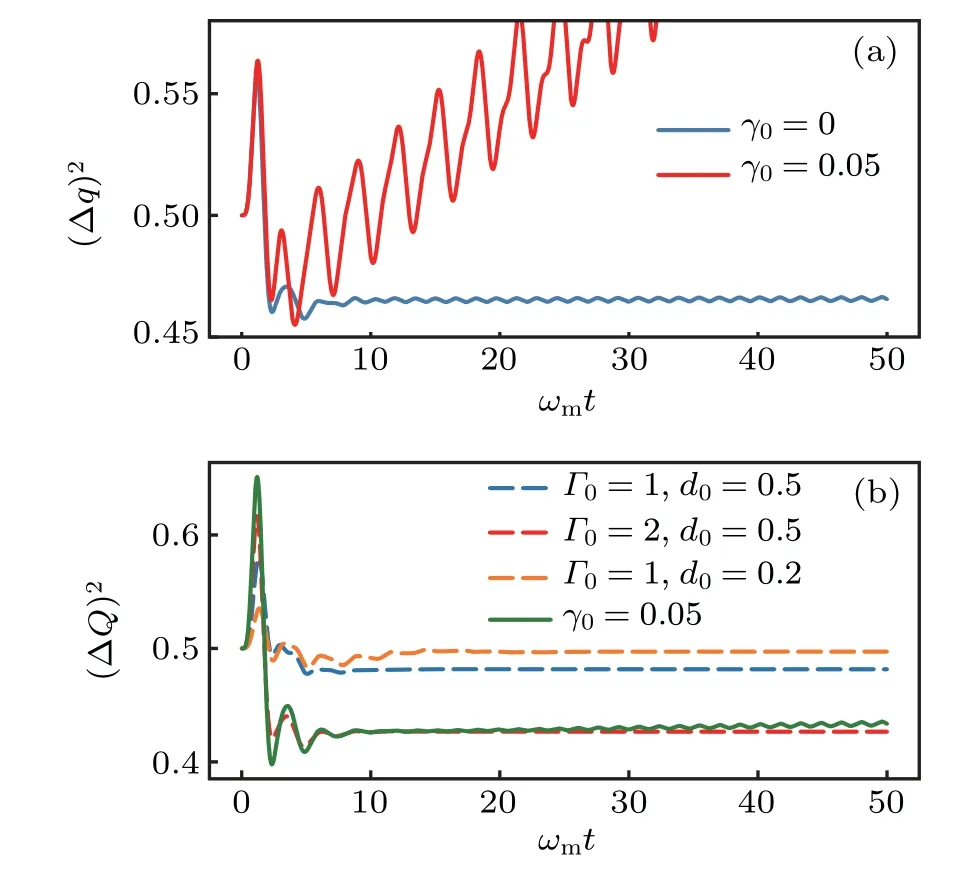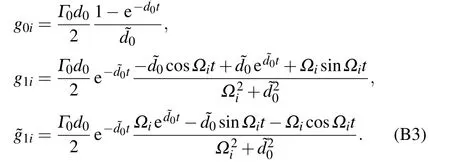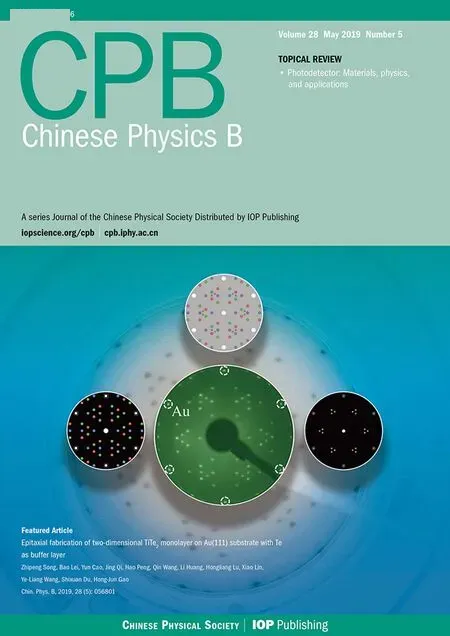Dynam icsof two levitated nanospheresnonlinearly coup ling with non-M arkovian environment*
Xun Li(李逊),Biao Xiong(熊标),ShileiChao(晁石磊),Jiasen Jin(金家森),and Ling Zhou(周玲)
SchoolofPhysics,Dalian University ofTechnology,Dalian 116026,China
(Received 6 January 2019;revisedmanuscript received 11March 2019;published online19April2019)
Keywords:non-Markovianity,levitated nanospheres,nonlinearity
1.Introduction
Trapping particles via an electromagnetic f ield isw idely researched theoretically and experimentally because of its potential application in precise instrument and macroscopic quantum effects detection.For example,an optical tweezer is applied to capture and control cells in biologicalandmedical research.The realization of Bose–Einstein condensation(BEC)and atom cooling have strict requirements for optical traps.[1–4]With the developmentof quantum techniques,the optical trap has been exploited in several research domains,such asgenerating squeezing states[5]andmacroscopic superposition states of trappedmatters,[6–8]entangling the trapped particles,[9,10]and cooling the trapped matter to ultra-low temperature.[11–14]Inaddition,thenonlinearity of the levitated system hasbeen reported in Refs.[12]–[17].The dynam icsof ananoparticle thatnonlinearly couplesto itsreservoirhasbeen theoretically studied in theMarkovian regime.[18,19]
Non-Markovian theory playsan important role in treating a realistic system.The non-Markovian environment usually can keep the coherence and suppress the dissipation.The theory ofopen quantum system is researched through severalperspectives,suchas theprojectionoperator theory,[20,21]Green’s functionsmethod,[22–24]perturbation theory,[25]and stochastic Schr¨odinger equations(SSEs)techniques.[26–30]However,these researchesmostly investigate the system linearly couplingwith itsnon-Markovian environment.However,the system coupled with its environment in nonlinear form remains under-studied.
In this paperwe consider two nanospheres trapped by a continuous frequency f ield and we w rite the Hamiltonian of the system with a nonlinear coupling to its environment.By employing quantum state diffusion(QSD)method,[28–30]we deriveanonlinearmasterequation.We investigate thedynamics of the two levitated nanosphereswith open quantum system techniques,and study the entanglement,squeezing of the two nanospheres,aswellas the state transfer.We f ind that the nonlinear coupling can improvenon-Markovianity.
2.M odeland Ham iltonian
We consider two nanospheres trapped by aw ideband cavity.The w ideband cavity f ield can be considered as a non-Markovian environmentof the two levitated nanospheres.As found in Refs.[5]and[17],the vibration frequency of the trapped nanospheres is on the order of kHz or MHz,which issmaller than thew idth of the trapping f ield.Thismeans that we can treatthe trapping f ieldsasaw ideband cavity.Recently,the crystalcavitywith engineeringmodes,whose frequency is continuous,hasbeen employed for trapping nanoparticles.[31]When acted upon by the optical forces,named the gradient force Fgradand the scattering force Fscatt,the two nanospheres can bedescribed asharmonic oscillators that linearly and nonlinearly couple to thew ideband cavity f ield(thedetail illustration can be seen in Ref.[6]).The Ham iltonian can bew ritten as

where ak(a†k)is theannihilation(creation)operatorof the k-th modewith detuningΔk,Ωiis the levitated frequency,qi(pi)is position(momentum)operatorof the i-th nanosphere,and Gkis the coupling between the k-th cavity f ield and nanospheres.
The Hamiltonian(1)describes the two nanospheres w rapped up by photon gaswith a continuous spectrum distribution,which is analogous to Brownianmotion.The system should be solved with non-Markovian theory.However,the third summation in Eq.(1)contains the nonlinear term in order of qiwhich differs from the usual linear non-Markovian interaction.The system can not be solved with the general non-Markovian theory asdone in Refs.[23]and[32].
To treat the nonlinear and non-Markovian dynamics,we employ QSDmethod.Forconvenience,we rew rite theHamiltonian into three parts,the free energy of the environment,the energy of the two nanospheres Hs=,and the interaction part,whereIt is convenient to change into the interaction picture rotatingwith HB,then we have the time-dependentHamiltonian

with

The open quantum system obeys thenon-Markovian quantum state diffusion equation

We assume the initial state of the system and environmentas|Ψ0〉=|ψ0〉⊗|01〉⊗···⊗|0k〉⊗.The system state|ψ0〉isarbitrary,and the initialstatesof the environmentare their ground states|0k〉.The totalstate|Ψt〉can beexpanded as

where |z〉= |z1〉⊗|z2〉⊗···⊗|zk〉···, and d2z=d2z1d2z2···d2zk···with identity forany Bargmann coherent state

The stochastic state of systemψt(z*)=〈z|Ψt〉obeys QSD equation


where is the correlation function of thebath.The variation in Eq.(7)can be taken place by some time-dependentoperator O satisfyingδψt/δz*s=O(t,s,z*)ψt.Therefore,the non-Markovian QSD equation(7)is rew ritten in apseudo-time-local form where¯O(t,z*)=∫t0f(t-s)O(t,s,z*)d s.Theoperators¯O and O satisfy




The reduced density operator of the open system can be obtained after partial trace operating over totalstate|Ψt〉,that is We denote the reduced density operatorρ(t)=ℳ[|ψt〉〈ψt|]with operatorensemblemeanℳ[·]=∫d z2/πe-|z|2[·]overall stochastic states.Themaster equation isobtained as However,it is still diff icult to f ind the exact solution of O and¯O with Eq.(10),especially when the system contains nonlinearormulti-particle interaction.An alternativemethod is to expand it in terms of the weak coupling strength,i.e.,O(t,s,z*)=∑nGnOn(t,s,z*),where G representsthecoupling strength.The lowestorderof thisoperator can bew ritten as by employing post-Markov approximation,which is valid when the square of the ratio of the environmentmemory time scale to system time scale is negligible.[33,34]The integrated operatorshould beexpressed as
我扫了一眼皮特和他的死党。德鲁比皮特和莫莉都矮,但他结实粗壮,体型比较圆,背老是驼着,一头橙红色的头发,就像老了的胡萝卜那种颜色。



where the coeff icients can be found in Appendix B.From Eq.(12),themasterequation with nonlinear terms isobtained as whereγiis the label of nonlinear coupling.The contributions of the linear and nonlinear couplings can be discussed by choosingγiequal to zero or not.In addition,themethod of themaster equation deduction(15)can be easily extended to thatwith nonlinear coupling.If the two nanospheres interactwith other f ieldsexcept the non-Markovian reservoir,then oneonly need to add their interaction into theHam iltonianand perform theabove procedureagain.
3.Squeezing of levitated nanospheres induced by thew ideband cavity f ield
From the f irst line of the summation in Eq.(15),we can obtain an effective interaction between the two nanospheres resulting from the linear coupling,i.e.,Heff=-∑i,jIm(g1i)qiqj,which can induce a self-squeezing and two-mode squeezing of thenanospheres.
Meanwhile,the nonlinear coupling between photon and phonon withγi/=0 inducesanothereffective interaction

which describesa Kerr effect.
Wewould like to investigate the effectof nonlinear coupling under Lorentz spectrum,which is a typicalexample to analyzean open system thanks to its realism in experiment,whereΓ0is thespectrum strength and d0is the spectrum w idth.

Fig. 1. The evolution of (a) single-mode fluctuation and (b) twomode fluctuation of the levitated nanospheres. In panel (a), Γ0 = 2ωm,d0 = 0.5ωm, and ΩCL =■2ωm. In panel (b), for the green line,Γ0 = 2ωm and d0 = 0.5ωm; for other dashed lines, γi = γ0 = 0. We let Ωi = ωm.
Squeezing can be quantif ied by the f luctuation of operators.Theposition f luctuation isdef ined as(Δq)2=〈q2〉-〈q〉2.The two-mode f luctuation can be def ined as(ΔQ)2=〈q2〉-.We chooseand assume that the initial states of the nanospheres are coherent states|αi〉withα1=1 andα2=0.As shown in Fig.1(a),the f luctuation(Δq)2with linear coupling attains a relative“stable”value(with weak amplitude oscillation).Whenγ0=0.05ωm,the single-mode squeezing f inally disappears after long time evolution.For two-mode squeezing,there is little difference forγ0=0.05ωmor not.Since the two-mode squeezing exhibits the correlation between the two nanospheres,the nonlinear coupling slightly affects the correlation.In addition,we can observe that the largerΓ0,the stronger the two-mode squeezing,becauseΓ0is the spectrum strength.The spectrum w idth d0also hasa little bit inf luence on the two-mode squeezing.One can see that the squeezing with d0=0.5ωmis stronger than thatwith d0=0.2ωmas shown in Fig.1(b),but it does notmean the bigger d0the stronger squeezing.In our simulation,we f ind that for d0=3ωm,there isno squeezing.If d0→∞,J(ω)=Γ0,then itisMarkovian and thesqueezing isobviouslyworse than that ofnon-Markovian.
4.Entanglementand state transfer
The two-mode squeezing represents the correlation between twonanospheres.Quantum entanglement,asanalternative correlation between two subsystems,can also be induced by effective interaction.The entanglement can bemeasured by negativity,which isdef ined as whereis the m ini-

mum symplectic eigenvalueof 2×2 block covariancematrix with elementandΣ(V)=det


Fig.2.The evolution of negativity whereΓ0=2ωm and d0=0.5ωm.Other parametersare the sameas those in Fig.1.
The effective interaction connects the two nanospheres,thus if the nanospheres are in different initial states ρ1(0),ρ2(0),then thestatesρ2(0)(ρ1(0))w ill transfer toρ1(t)(ρ2(t))through effective interaction.We employ the conversion f idelityℱ(ρ1,ρ2)=tomeasure the eff iciency of state transfer.[35]We plot the f idelity in Fig.3.We can observe that the f idelity oscillates periodically with decreasing amplitude,whetherornot thenonlinear coupling exists.Whenγ0=0.05ωm,the f idelity is obviously worse than thatwithγ0=0.Themaximum f idelity can reach0.9,which is relative ideal,while theentanglement isweak(see Fig.2)and thesqueezing isnotso deep(see Fig.1).Thishappensbecause the equal frequency of the two nanospheresmakes the effective interaction induced by linearcoupling Heffwithbeam split(BS)form,therefore the state transfer can be achieved while the squeezing and theentanglementarenotso ideal.

Fig.3.Theevolution of f idelity.Otherparametersare thesameas those in Fig.1.
5.Non-M arkovianitymeasure
We have shown that squeezing,entanglement,and state transfer between the two nanospheres can be achieved in our system.These properties result from their common coupling with the samenon-Markovian environment;i.e.,relatingwith the non-Markovianity in the present system.We now investigate the non-Markovianity of the system.For the non-Markovianitymeasure,several proposals[36–39]based on violation of dynam icalsem igroupsor information backf low have been put forward.Here,we employ the measure of non-Markovianity proposed in Ref.[36]whereσ(t)=is the derivative of trace distance between different initialstatesρ1,2Sand



Fig.4.(a)The non-Markovianity measure as a function ofγ0 where Γ0=ωm.(b)The tracedistancebetween two differentinitialstatesρ1,2S forΓ0=2ωm and d0=0.5ωm.Other parametersare the same as those in Fig.1.
6.Discussion and conclusion
We investigate two nanospheres that are trapped in a w ideband cavity f ield,where the two nanospheresnonlinearly couple with the environment.Themain contribution of this work is thatwe put forward amethod to treatnon-Markovian dynamicswith nonlinear coupling.A master equation of the nonlinear non-Markovian system is derived,in which the effective linearand nonlinear interactionscan be induced,which can generate the squeezing,entanglement,and realize state transfer.We study the inf luence of this nonlinear coupling on the dynamics of the system.We f ind that the nonlinear coupling can improvenon-Markovianity.Aftera long enough evolution,the nonlinear coupling w ill damage the squeezing and entanglement because the nonlinearity enlarges the loss rate.To compensate for the loss of the system,one can introduce another pumping f ield.In addition,one can see that the entanglement and the squeezing are not as good as the state transfer because the equal frequency of the two nanospheres results in themain interaction with beam split form.If one would like to obtain large entanglement and squeezing,then one couldmanipulate the two nanosphereswith red and blue detunings,respectively.The spectrum of the environmentdependson the distribution of the cavity f ield,which can bemanipulated.Therefore,itmightbe away to simulate the spectrum of theenvironment to study thenon-Markovian system.
Acknow ledgement
Appendix A:The nonlinear coup ling
The levitated nanospheres are trapped by an electromagnetic f ield.They receive the optical forces,namely the gradient force Fgradand the scattering force Fscattaccording to the generationmechanism.[44]The Fgradand Fscattcan be described as

where ktrap∝|E|2with E being theelectromagnetic amplitude of the cavity f ield,βis a constant number formarking the scattering force,and q is the position of the nanosphere.The motion of the levitated nanosphere issimpleharmonic oscillation where the gradient force actsas the restoring force.[17,44]The Ham iltonian of the levitated nanosphere can bew ritten as

where p is themomentum operator of the nanosphere,and m is themass.Assuming ktrap=χa†a with a constant coeff icientχ,where a(a†)is theannihilation(creation)operatorof the cavity f ield,the stiffness factor ktrapcan be expanded as ktrap=χ(|α|2+α*a+αa†)with mean-f ield approximation a→α+a.The Ham iltonian of the nanosphere and cavity f ield can be rew ritten as

whereΩ=χ|α|2/2 is the frequency of the nanosphere,the operators q and p are changed to dimensionless ones with,respectively,and the constant partχ|α|2q inducing a displacementhas been neglected,because it can be canceled just by displacing the zero-point of the oscillator.represents the nonlinear coupling strength.The f irst term is the energy of the cavity f ield with detuningΔ=ωc-ωL(ωcandωLare the frequencies of the cavity f ield and the classical pumping f ield,respectively),the second term denotes the energy of the harmonic oscillator,and the third term describes the coupling between the cavity f ield and themechanicaloscillator.
Appendix B:Coeff icients
The time-dependentcoeff icientsof Eq.(14)can be calculated by Eq.(13)as
Wewould like to thank Xinyu Zhao andW.L.Liforhelpfuldiscussions.is the coupling between the nanosphere and cavity f ield,and


For Lorentz form spectrum,the time correlation function is f(t)=,where˜d0=d0+iΩCL,and thecoeff icients can be solved as

WhenΩCL→0,d0→∞corresponds to Markovian situation,then g0(t)=Γ0/2,g1(Ωi,t)=Γ0/2,˜g1(Ωi,t)=0,which means that there is no effective interaction exceptdissipation.In contrast,when d0≪Ωithe non-Markovian propertiesmay occur,we can obtain

withΩCL/=Ωi.As discussed in themain text,the imaginary partof g1(Ωi,t)generates theeffective interaction between the two nanosphere.
- Chinese Physics B的其它文章
- Photoinduced phase transitions in two-dimensional charge-density-wave1T-TaS2*
- Low-tem perature grow th of large-scale,single-crystallinegrapheneon Ir(111)*
- Epitaxial fabrication of two-dimensional TiTe2 monolayer on Au(111)substratew ith Teasbuffer layer*
- Isotopeeffectand Coriolis coup ling effect for the Li+H(D)Cl→LiCl+H(D)reaction*
- V ariationaland diffusion M onte Carlo simulationsof a hydrogen molecular ion in a sphericalbox*
- General way to def ine tunneling time*

